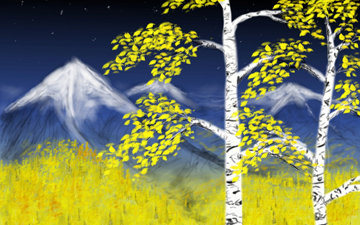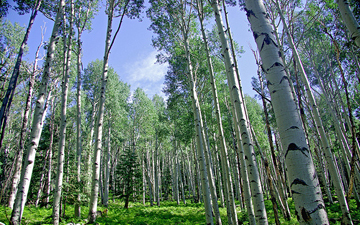Populus tremuloides is a deciduous tree native to cooler areas of North America. The species is referred to Quaking Aspen, Trembling Aspen, and Quakies, names deriving from its leaves which flutter in the breeze.[1] The tree-like plant has tall trunks, up to 25 metres, with smooth pale bark, scarred with black. The glossy green leaves, dull beneath, become golden to yellow, rarely red, in Autumn. The species rarely flowers, often propagating through its roots to form large groves.
(From Wikipedia, April 26, 2010)
– – –
This is a native tree 5-30 m high, typically less than 15 m, with a rounded crown; lateral roots may extend over 30 meters and vertical sinker roots from the laterals may extend downward for nearly 3 m; bark typically smooth, greenish-white to gray-white, often thin and peeling, becoming thicker and furrowed with age, especially toward the base. Leaves simple, deciduous, broadly ovate to nearly round, 4–6 cm long, with small, rounded teeth on the margins, on a slender, flattened petiole, dark green and shiny above, pale green below, turning bright yellow, yellow-orange, gold, or reddish after the first frosts. The male (staminate) and female (pistillate) flowers are on separate trees (the species dioecious – or ‘polygamodioecious,’ because bisexual flowers may be produced at low frequencies on staminate and pistillate trees), each type of flower borne in pendent catkins. The fruits are narrowly ovoid to flask-shaped capsules 5-7 mm long, splitting to release the seeds; seeds ca.2 mm long, each with a tuft of long, white, silky hairs, easily blown by the wind. The common name is in reference to the shaking of the leaves in light wind.
(From EOL via plants.usda.gov, April 25, 2010)
– – –





